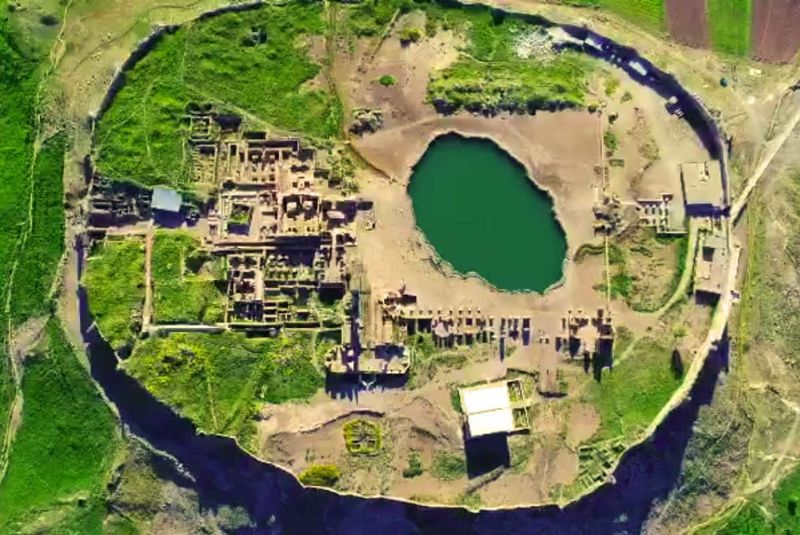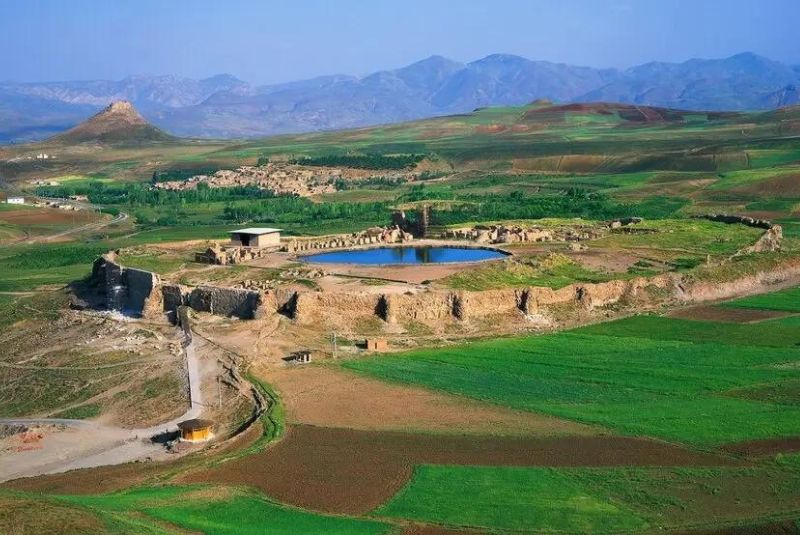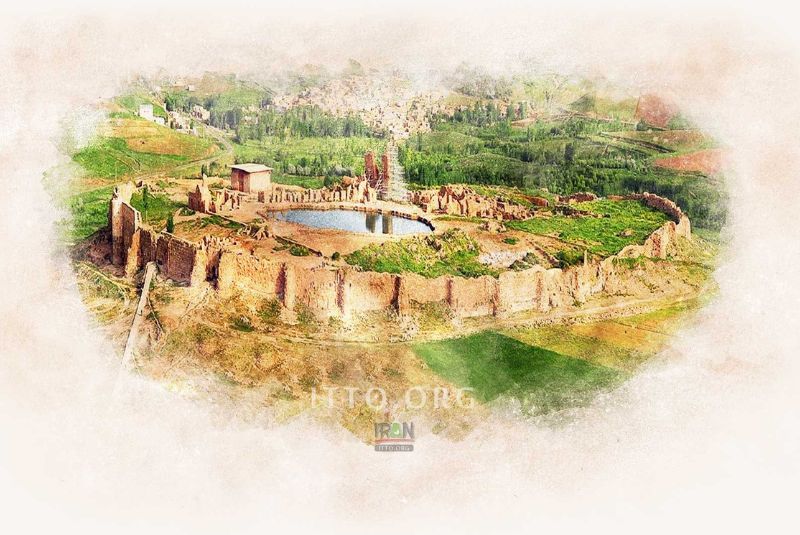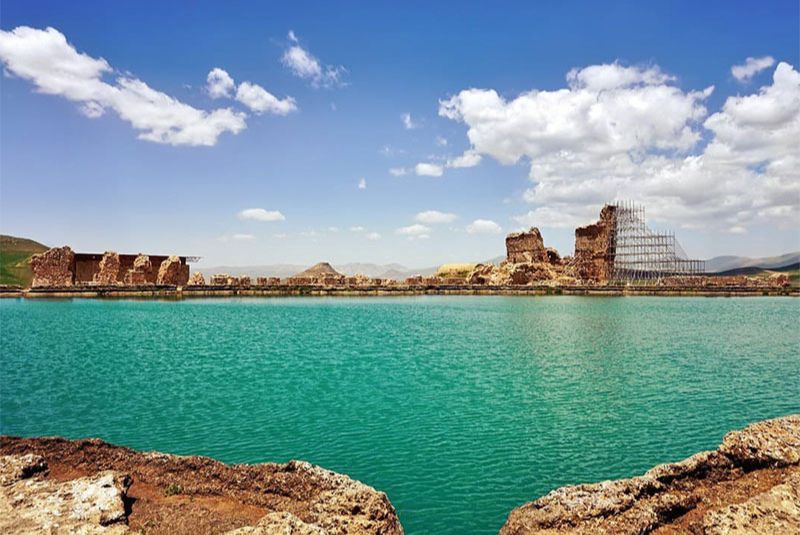Takhte Soleyman (Throne of Solomon), UNESCO World Heritage Site
In the northwestern part of Iran, there is a World Heritage Site called Takhte Soleyman, or the Throne of Solomon.
It is a unique and magnificent complex that dates back to the Sassanid era, which was one of the most significant periods in Iranian history. The site has been recognized as a UNESCO World Heritage Site since 2003 due to its cultural and historical importance.
The Takhte Soleyman complex consists of several structures, including a Zoroastrian fire temple, a palace, and a lake
The site was considered sacred by Zoroastrians and was believed to be the dwelling place of their god, Ahura Mazda. Later on, during the Sassanid era, it became an important center for political and religious activities.
The UNESCO World Heritage Site designation is an important recognition for Takhte Soleyman. It highlights the significance of this historical site not only for Iran but also for humanity as a whole. This designation ensures that Takhte Soleyman will be preserved and protected for future generations to appreciate and learn from.
Takhte Soleyman Location and Access
Takhte Soleyman, also known as the Throne of Solomon, is a UNESCO World Heritage Site located in the northwest of Iran. The site is situated on a volcanic plateau at an altitude of 2,000 meters above sea level and is surrounded by stunning mountain ranges. The geographical location of Takhte Soleyman makes it a unique and breathtaking destination for tourists from all over the world.

Getting to Takhte Soleyman can be an adventure in itself. The site is located approximately 45 kilometers from the city of Takab, which can be reached by car or bus from major cities such as Tehran and Tabriz. From Takab, visitors can take a taxi or hire a private car to reach the site. Alternatively, there are also organized tours available that include transportation to and from Takhte Soleyman.
For those who prefer to travel by air, the nearest airport is located in Tabriz, which is approximately 300 kilometers away from Takhte Soleyman. From Tabriz, visitors can take a bus or hire a private car to reach the site.
Once at Takhte Soleyman, visitors can explore the ancient ruins and learn about the rich history of this UNESCO World Heritage Site. The site includes several structures such as the Temple of Anahita, which dates back to the Parthian era, and the Fire Temple of Sassanid era. Visitors can also enjoy stunning views of Lake Urmia and the surrounding mountains.
| Suggestion: Persian Garden | A Piece of Paradise in Iran
Architecture and Design
Main Structures

Located in Iran's northwest, Takhte Soleyman or the Throne of Solomon is a World Heritage Site that UNESCO has endorsed. The site is home to several impressive structures that showcase the architectural and design prowess of ancient Persians. The main structures at Takhte Soleyman include the Azar Goshnasp Temple and the Anahita Temple.
The Azar Goshnasp Temple is one of the most impressive structures at Takhte Soleyman. This temple was dedicated to the worship of fire, which was an important aspect of Zoroastrianism. The temple's design features a central courtyard surrounded by a series of rooms and halls. The walls are adorned with intricate carvings and reliefs depicting scenes from Zoroastrian mythology.
The Anahita temple is another impressive structure at Takhte Soleyman. It was built during the Parthian era and dedicated to Anahita, the goddess of water and fertility. The temple features a rectangular design with a central hall that was used for religious ceremonies. The walls of the temple are decorated with beautiful frescoes that depict scenes from Persian history and mythology.
| Suggestion: Naqsh-e Rustam | Ancient Treasures & Zoroastrian Legacy
Unique Features of the Architecture and Design

The Throne of Solomon, or Takhte Soleyman, is a place in Iran's northwest that UNESCO has listed as a World Heritage Site. The site is renowned for its unique architecture and design, which reflects the cultural and historical significance of the region. One of the most striking features of Takhte Soleyman is its circular shape, which is believed to represent the sun and its eternal cycle. This circular design is also reflected in the layout of the buildings and structures within the site.
Another unique feature of Takhte Soleyman's architecture is its use of water. The site includes a large lake that was created by diverting a nearby river. This lake not only adds to the beauty of the site but also serves as an important part of its religious significance. The Zoroastrian religion, which was practiced at Takhte Soleyman, placed great importance on water as a symbol of purity and renewal.
The buildings at Takhte Soleyman are also notable for their intricate design and decoration. The main structure, known as the Fire Temple, features intricate carvings and reliefs that depict scenes from Zoroastrian mythology. The walls are adorned with images of gods, heroes, and mythical creatures that reflect the beliefs and values of ancient Persian culture.
Cultural Significance
Historical and cultural significance of Takhte Soleyman

Takhte Soleyman or the Throne of Solomon is a World Heritage Site in northwest Iran recognized by UNESCO. This ancient site has a rich historical and cultural significance that dates back to the Sassanid era. The site is believed to have been a sacred place for Zoroastrians, who considered it as the holiest of their fire temples.
The site was later transformed into a royal palace during the reign of King Khosrow I, who built a magnificent palace complex around the sacred lake. The palace was used by various Sassanid kings and queens as their summer residence and was considered one of the most luxurious palaces in the world at that time.
Apart from its historical significance, Takhte Soleyman also holds great cultural importance for Iranians. It is considered a symbol of national pride and identity, representing Iran's rich cultural heritage and ancient civilization. The site has been an inspiration for many Iranian poets, writers, and artists throughout history.
Role in Ancient Persian Religion and Mythology

The ancient Persian religion and mythology played a significant role in shaping the cultural significance of Takhte Soleyman. The site was considered a sacred place by the Zoroastrians, who believed that it was the dwelling place of their god, Ahura Mazda. According to legend, the site was chosen by the god himself as a place where he could communicate with his followers.
The importance of Takhte Soleyman in ancient Persian religion is evident in the many temples and shrines that were built on its grounds. The most notable of these is the Temple of Anahita, which was dedicated to the goddess of fertility and water. The temple was built around a natural spring, which was believed to have healing powers.
In addition to its religious significance, Takhte Soleyman also played an important role in Persian mythology. According to legend, King Solomon visited the site during his travels and was so impressed by its beauty that he decided to build a palace there. The palace was said to be so magnificent that it inspired envy in even the gods themselves.
Today, Takhte Soleyman remains an important cultural landmark in Iran and a testament to the rich history and mythology of ancient Persia. Its UNESCO World Heritage status ensures that it will continue to be preserved for future generations to appreciate and learn from.
Activities and Attractions

A World Heritage Site acknowledged by UNESCO which is Takhte Soleyman, also known as the Throne of Solomon. This ancient site is home to a plethora of tourist activities that are sure to delight visitors from all walks of life. One of the most popular activities available at Takhte Soleyman is hiking. The surrounding mountains offer breathtaking views and challenging trails that are perfect for adventurous travelers.
In addition to hiking, sightseeing is another popular activity at Takhte Soleyman. The site boasts a number of impressive structures, including an ancient Zoroastrian fire temple and a stunning lake that is said to have healing properties. Visitors can take guided tours of the site to learn more about its rich history and cultural significance.
For those looking to explore nearby attractions, there are plenty of options available as well. Just a short drive from Takhte Soleyman is the city of Tabriz, which is home to several historic sites and museums. The Tabriz Historic Bazaar Complex, for example, is one of the oldest and largest covered bazaars in the world and offers an immersive shopping experience unlike any other.
Another nearby attraction worth visiting is the Kandovan Village, which features unique cave dwellings carved into volcanic rock formations. Visitors can explore these fascinating dwellings and learn about the traditional way of life in this remote region.
Accommodations and Dining Options

Takhte Soleyman, also known as the Throne of Solomon, is a historical site located in the northwest of Iran. It is a UNESCO World Heritage Site and attracts thousands of visitors every year. If you are planning to visit Takhte Soleyman, you will need to find suitable lodging options nearby. Fortunately, there are several options available that cater to different budgets and preferences.
One of the most popular lodging options near Takhte Soleyman is the traditional Iranian guesthouse. These guesthouses offer a unique experience for visitors who want to immerse themselves in Iranian culture. The guesthouses are usually decorated with traditional Persian carpets and artwork, and they serve authentic Iranian cuisine for breakfast, lunch, and dinner. Staying at a traditional Iranian guesthouse is an excellent way to experience the local culture and hospitality.
If you prefer more modern accommodations, there are several hotels near Takhte Soleyman that offer comfortable rooms and amenities such as swimming pools and spas. These hotels cater to different budgets and preferences, so you can choose one that suits your needs.
When it comes to dining near Takhte Soleyman, there are several restaurants that serve traditional Iranian cuisine. Iranian cuisine is known for its rich flavors and use of herbs and spices such as saffron, turmeric, and cumin. Some popular dishes include kebabs, stews (such as ghormeh sabzi), rice dishes (such as tahchin), and various types of bread (such as lavash).

Finally!
If you're planning a trip to Iran, be sure to add Takhte Soleyman to your itinerary. This UNESCO World Heritage Site offers visitors an incredible opportunity to explore one of Persia's most important historical landmarks. From its unique architecture to its rich cultural significance, there's something for everyone at Takhte Soleyman.
So pack your bags and get ready for an unforgettable journey through time!


Comment
Leave a Comment